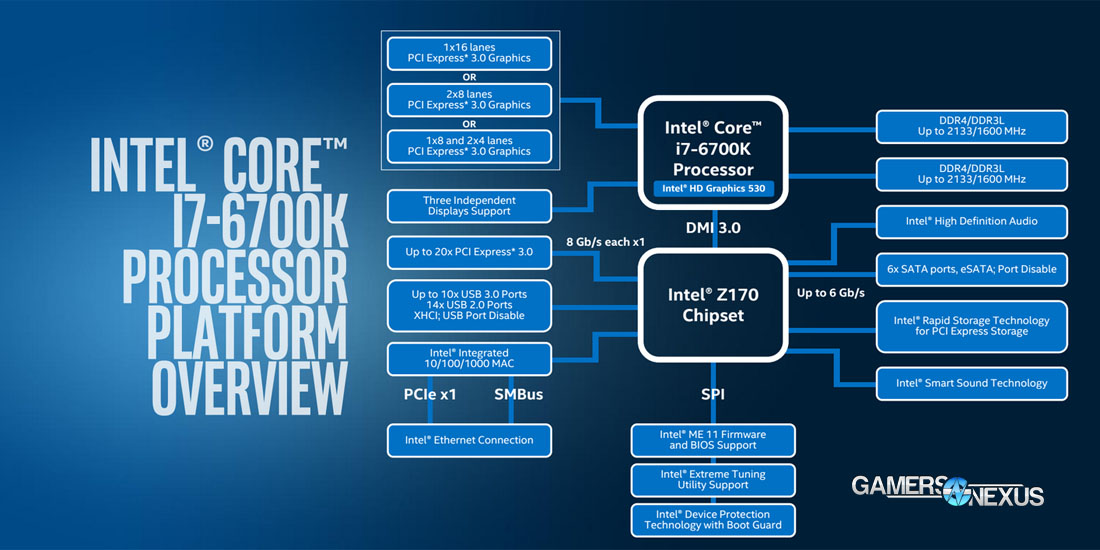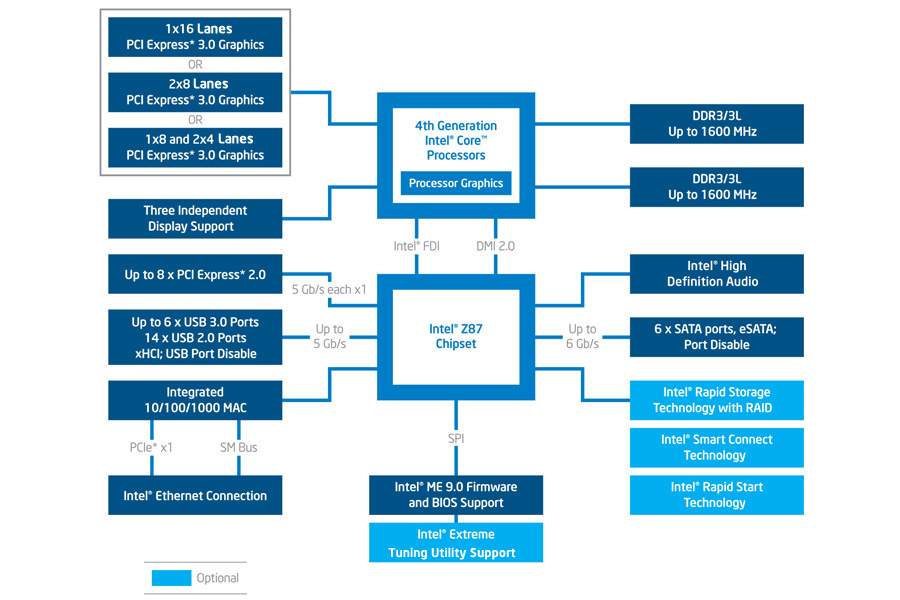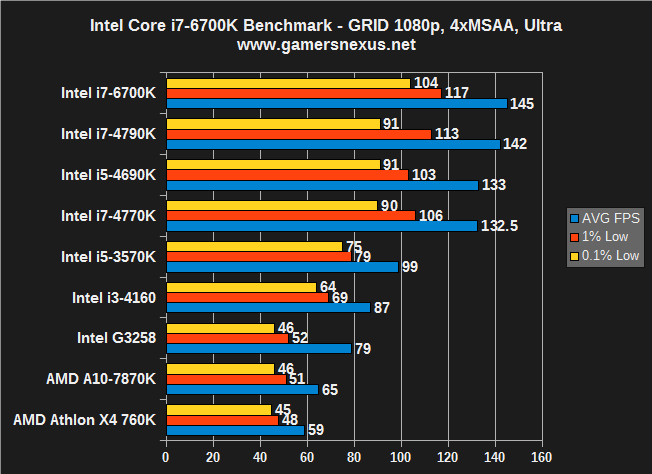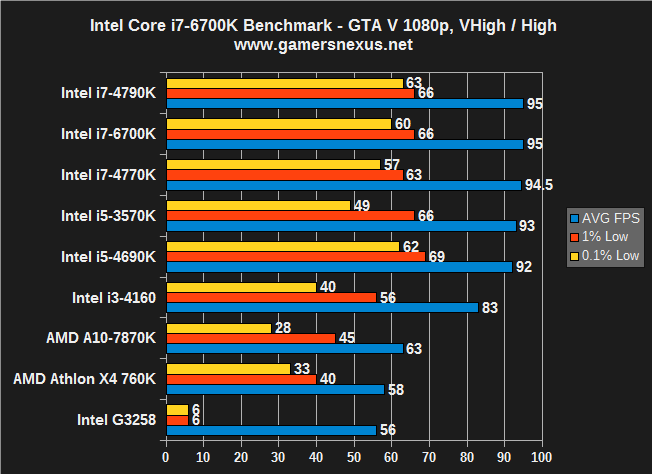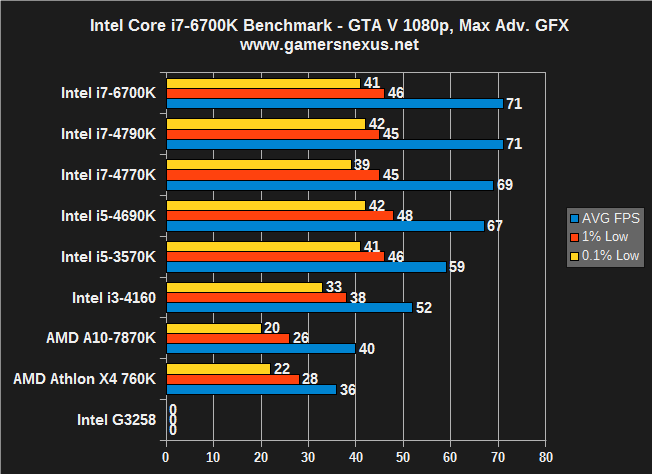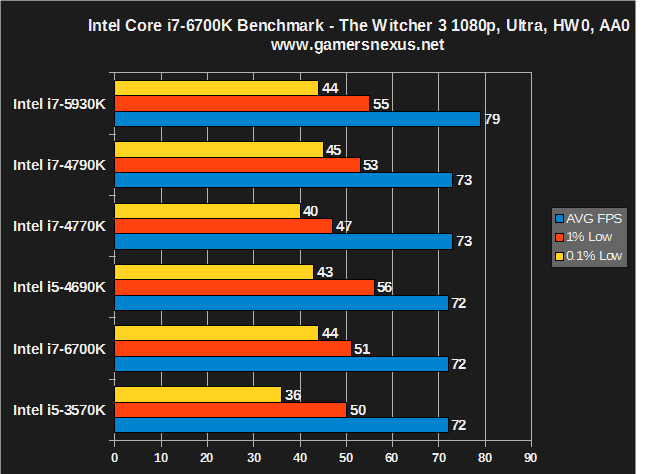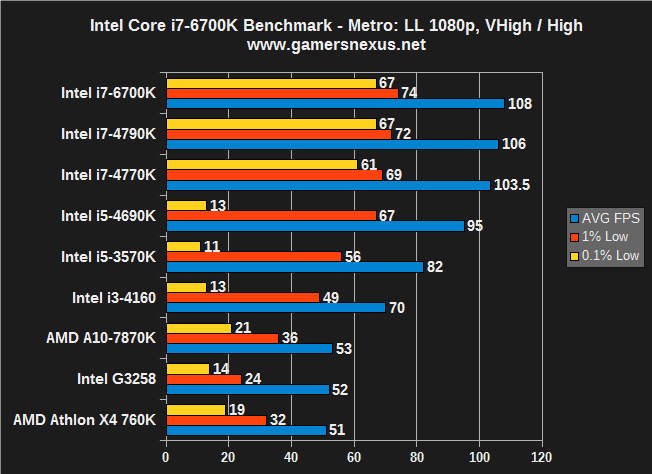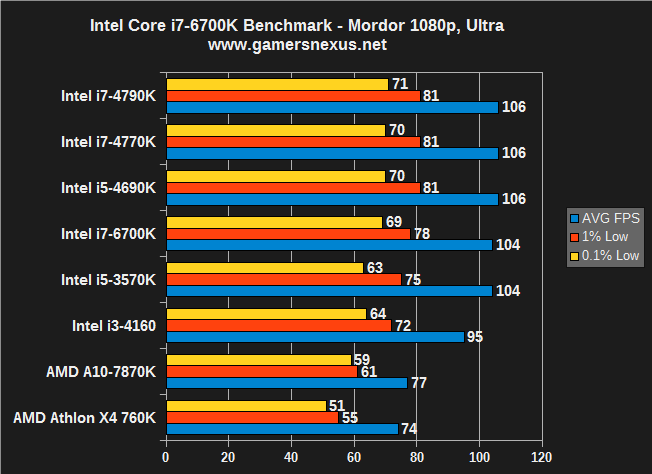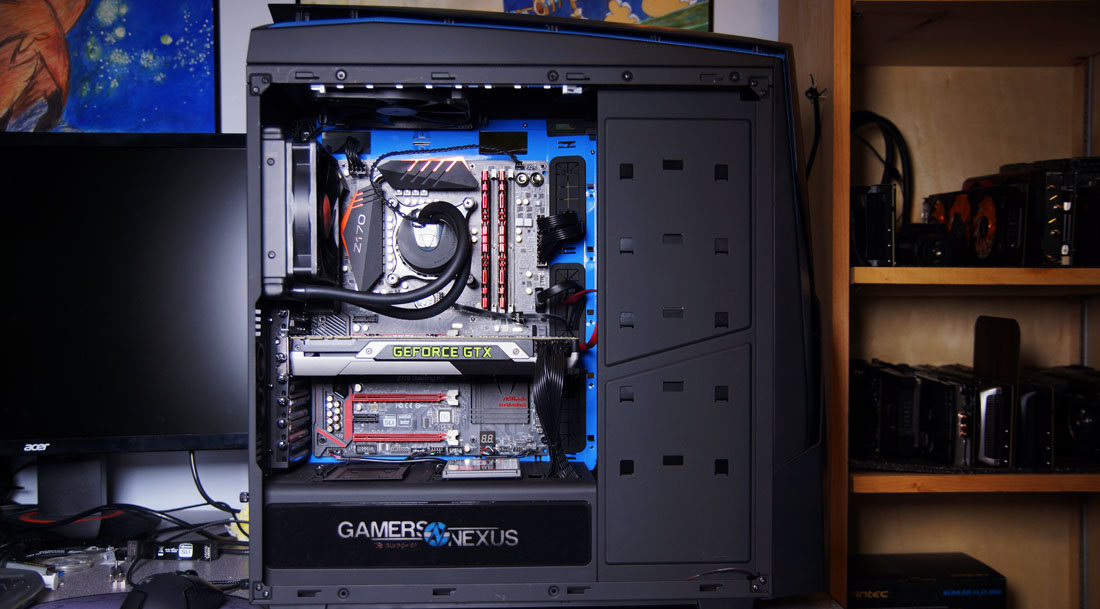Today marks the public release of Intel's codename “Skylake-S” platform, a new 14nm microarchitecture designated for use in the company's newest line of CPUs. The Core series CPUs see accompaniment from a new Z170 chipset, found on each of the motherboards included in our Skylake Z170 board round-up. Skylake is targeted heavily at the PC gaming userbase, which is currently experiencing a heavy surge in platform adoption.
Intel's platform flagship is the i7-6700K ($350), sticking to the well-known 4-core, 8-thread approach by way of matured hyperthreading technology. Prior to Skylake, Intel shipped its Devil's Canyon update to Haswell, a worthwhile, same-price replacement with slightly bolstered clockrates. The “Haswell Refresh” CPUs have been mostly forgotten at this point, but were released in close proximity to Devil's Canyon. This string of same-generation releases is uncharacteristic of Intel, who generally launch the mainstay i7 and i5 for each architecture before immediately shifting gears to the next platform release.
The i7-6700K effectively replaces the i7-4790K (2014) in the stack, which replaced the i7-4770K (2Q13). The i5-6600K ($240) replaces the i5-4690K, which replaced the i5-4670K before it. The Skylake branding makes a return to what is more familiarized from Sandy Bridge, dropping the XX7X identifier.
We're going to be publishing various components of this CPU review in bursted increments. Our objective is to explore several individual facets in more depth (as it relates to video graphics, especially), and that will require more time than we were given before launch. This review is an initial analysis of hard gaming performance. Overclocking, power, thermals, PCI-e lane scalability, and more are forthcoming.
Today, we're reviewing Intel's Skylake i7-6700K CPU on the Z170 chipset; we've dedicated all of our efforts to gaming benchmarks to analyze FPS gain using the i7-6700K. The new CPU was pitted against other Intel models of recent years, including the 4770K, 4790K, and i5- models 4690K and 3570K. Production workload tests will be performed separately from this initial review and will release in the future. Our focus today is entirely on gaming and overclocking.
Intel Core i7-6700K & i5-6600K CPU Specs
| i5-4670K | i5-6600K | i7-4770K | i7-6700K | |
| Cores | 4C/4T | 4C/4T | 4C/8T | 4C/8T |
| Frequency | 3.4GHz / 3.8GHz T | 3.5GHz / 3.9GHz T | 3.5GHz / 3.9GHz T | 4.0GHz / 4.2GHz T |
| EUs | 20 | 24 | 20 | 24 |
| IGP | HD4600 | HD 530 | HD4600 | HD 530 |
| IGP Frequency | 1200MHz | 1150MHz | 1250MHz | 1150MHz |
| TDP | 84W | 91W | 84W | 91W |
| Cache | 6MB L3 0MB L4 | 6MB L3 0MB L4 | 8MB 0MB | 8MB 0MB |
| DRAM Frequency | 1600MHz DDR3L | 1600MHz DDR3L 2133MHz DDR4 | 1600MHz DDR3L | 1600MHz DDR3L 2133MHz DDR4 |
| Socket | LGA1150 | LGA1151 | LGA1150 | LGA1151 |
| Cost | $240 | $240 | $340 | $350 |
DDR4 feels a little “stale” given its X99 launch but, for the mass consumer market, Skylake will be the first time that DDR4 lands on the buying list. Skylake is technically capable of supporting both DDR4 and DDR3L (2133MHz and 1600MHz natively, respectively), but all gaming-grade boards we've got access to host DDR4 slots.
DDR4 is still expensive. It'll come down as the market undergoes a massive switch-over, something we've already forecast for 2016. The added cost of DDR4 inflates overall system build cost in a sort of “hidden” fashion at this point.
Intel's i7-6700K and i5-6600K are equipped with the new HD 530 IGP, something we omitted from testing due to unavailability of the driver in time for launch.
The Z170 Chipset Architecture vs. Z97
Above is the new block diagram for Intel's Z170 chipset, its latest performance-series brain stem. The existing Z87 / Z97 chipset is also on display.
The biggest and most immediate gain from Z170 is its additional lane availability. Z97 coupled with a Haswell processor yields a combined 24 PCI-e lanes (a mix of 2.x and 3.0), something that constricts options when dealing with multi-GPU and modern SSD configurations. A single GPU instantly consumed 16 lanes – whether or not it measurably benefits from the full allocation – and M.2 SSDs will use another 4 lanes. Multi-GPU + M.2 / NVME configurations instantly saturate the entirety of the PCI-e controllers.
Skylake itself still hosts the same lane count on the new i7 and i5 flagships as Haswell, but increases the chipset's availability to 20 lanes. The total PCI-e lane availability with this configuration now rests at 36, a big enough gain to allow full dual x16 GPU configurations with an SSD routed through the PCI-e bus.
Intel is looking out for its own interests, here: Its 750 Series SSDs use PCI-e lanes on the motherboard to gain the tremendous speed output, something also true of the HyperX Predator SSD and any other M.2 or PCI-e SSDs on the market. Progress is always good, but this is also a strategic move to prepare the market for ultra fast SSD consumption.
A less interesting footnote, the Z170 chipset also bolsters USB3.0 support to 10 ports natively (from 6 on Z87).
Test Methodology
iBUYPOWER provided a complete Skylake system for review on loan.
We tested using our updated 2015 GPU test bench, detailed in the table below. Our thanks to supporting hardware vendors for supplying some of the test components.
The latest AMD Catalyst drivers (15.7.1) were used for testing. NVidia's 353.62 drivers were used for testing. Game settings were manually controlled for the DUT.
Testing was focused on CPU bottleneck analysis. To test at what point the CPU bottlenecks a high-end GPU, we equipped all platforms with a GTX 980 Ti and performed tests using the following settings:
- Metro: Last Light - Very High w/ high tessellation.
- GRID: Autosport - Ultra, 4xMSAA.
- Shadow of Mordor - Ultra preset.
- GTA V - Very High / High.
- GTA V - Very High / High with Advanced Graphics (to find bottlenecks).
- Witcher 3 - Ultra, with SSAO, HairWorks off, and AA off.
- FireStrike (normal).
All tests had the resolution set to 1080p.
Each game was tested for 30 seconds in an identical scenario, then repeated three times for parity.
Average FPS, 1% low, and 0.1% low times are measured. We do not measure maximum or minimum FPS results as we consider these numbers to be pure outliers. Instead, we take an average of the lowest 1% of results (1% low) to show real-world, noticeable dips; we then take an average of the lowest 0.1% of results for severe spikes. Anti-Aliasing was disabled in all tests except GRID: Autosport, which looks significantly better with its default 4xMSAA. HairWorks was disabled where prevalent. Manufacturer-specific technologies were used when present (CHS, PCSS).
Here is the Intel test bench:
| GN Test Bench 2015 | Name | Courtesy Of | Cost |
| Video Card | GTX 980 Ti | NVIDIA | - |
| CPU | Intel i7-4790K CPU Intel i5-4690K CPU Intel i3-4160 CPU Intel G3258 CPU | CyberPower GamersNexus GamersNexus GamersNexus | - |
| Memory | 16GB 2133MHz HyperX Savage RAM | Kingston Tech. | $300 |
| Motherboard | Gigabyte Z97X Gaming G1 | GamersNexus | $285 |
| Power Supply | NZXT 1200W HALE90 V2 | NZXT | $300 |
| SSD | HyperX Predator PCI-e SSD | Kingston Tech. | TBD |
| Case | Top Deck Tech Station | GamersNexus | $250 |
| CPU Cooler | Be Quiet! Dark Rock 3 | Be Quiet! | ~$60 |
The Skylake bench made the following exceptions to the above:
- Intel Core i7-6700K CPU
- 16GB 2133MHz G.Skill DDR4 Memory
- ASRock Z170 Fatal1ty Gaming K6 motherboard
And the AMD bench:
| GN Test Bench 2015 | Name | Courtesy Of | Cost |
| Video Card | GTX 980 Ti | NVIDIA AMD | - |
| CPU | AMD A10-7870K AMD Athlon X4 760K | AMD GamersNexus | - |
| Memory | 16GB 2133MHz HyperX Savage RAM | Kingston Tech. | - |
| Motherboard | ASUS A88X-PRO | GamersNexus | $285 |
| Power Supply | NZXT 1200W HALE90 V2 | NZXT | $300 |
| SSD | HyperX Savage SSD | Kingston Tech. | TBD |
| Case | Top Deck Tech Station | GamersNexus | $250 |
| CPU Cooler | Be Quiet! Dark Rock 3 | Be Quiet! | ~$60 |
Continue to page 2 for the benchmark charts.
Note: Some tests were conducted additional times for parity. We test a minimum of three passes for each benchmark to ensure accuracy. In some instances -- like the Witcher 3 tests -- we double-up on passes to ensure the disparity seen is more significant than margin of error.
Intel i7-6700K vs. 4770K, 4790K GRID: Autosport Benchmarks
GRID: Autosport reveals a slight disparity between 4790K and 6700K performance.
At 145 FPS against 142 FPS, there's hardly anything to write home about. Both the 4790K and 6700K offer high enough framerates to fulfill 144Hz display demands (assuming the GPU cooperates), with similarly high 0.1% low metrics.
Intel i7-6700K vs. 4770K, 4790K GTA V CPU Benchmarks
GTA V shows effectively zero difference between the Haswell i7 units and newcomer Skylake:
The 6700K and 4790K are effectively tied (0.1% disparity is within margin of test error). We don't see much difference until dropping down to an i3 in GTA V. The G3258 – although it is on this chart – is unplayable at these settings, as indicated by 0.1% and 1% lows.
Intel i7-6700K vs. 4770K, 4790K The Witcher 3 CPU Benchmarks
The Witcher 3 exhibits seemingly anomalous performance. We performed additional test passes on the Witcher 3 to ensure a larger dataset. Each test pass placed the 6700K below our other CPUs (aside from the generations-old 3570K), something that we'd attribute to lower IPC or a mix of DDR4 CAS timing differences.
Intel i7-6700K vs. 4770K, 4790K Metro: Last Light Benchmarks
Metro: Last Light shows a slight difference, as GRID did:
The 6700K marginally leads the 4790K with a 2FPS delta. Not much exciting here by way of FPS jumps, but an improvement nonetheless. The Ivy Bridge architecture is led more dramatically, though it's also a 4C/4T 3570K and Metro very clearly fronts a hyperthreading bias.
Intel i7-6700K vs. 4770K, 4790K Shadow of Mordor Benchmarks
As with some of the other games, Shadow of Mordor shows effectively zero difference between Haswell and Skylake CPUs when it comes to 1080p gaming on a 980 Ti.
Intel i7-6700K Overclocking
We struggled to overclock our i7-6700K. Our sample is an engineering sample running on a pre-production motherboard, though both should be as close to the end product as possible without being actual retail devices.
Here's our chart of simplified changes:
| Multiplier | vCore | Pass / Fail |
| 44 | 1.280v | P |
| 46 | 1.280v | F |
| 46 | 1.320v | P |
| 47 | 1.320v | F |
| 47 | 1.350v | F |
| 47 | 1.360v | F |
We ultimately settled on 4.6GHz at 1.30v for the i7-6700K. Time restricted the ability to dive deeper with some of the new cache and BCLK unlocks, but this is a topic we will revisit in greater depth in the immediate future. A full article will be dedicated to Skylake overclocking once we've got a better feel for what's preventing a sturdier OC than our 4.6GHz output.
Conclusion
The biggest advantage of moving to a Skylake / Z170 platform is in memory capabilities, for those who can't afford X99 but may perform tasks that'd benefit from DDR4. Gaming is not one of those tasks (there may actually be slight overhead for gaming). Video production and photo editing immediately see benefit from DDR4.
After the memory change, the next most noteworthy improvement over Z87/Z97 is the lane increment. At 36 lanes, Skylake and Z170 support more expansion devices than its 24-lane predecessor. This is something we won't tap into until our next test, which will explore lane scalability on multiple platforms using various, real-world PCI-e configurations.
As it stands here and now, today, the i7-6700K feels similar to most of Intel's other recent launches. For anyone on a remotely recent architecture, there's just no reason to make the jump to Skylake unless for memory reasons – and those users likely know who they are. For gamers, anyone from Sandy Bridge onward should still be happily limited more by the GPU than the CPU. At a couple FPS – if lucky – Skylake isn't a raw framerate-boosting platform. It's more focused on technology, shrinking the process, and adding DDR4 to the consumer marketplace. The processor certainly isn't bad, it's just not exciting. Anyone who would have purchased a 4770K or 4790K should now consider the 6700K instead (assuming memory cost is a non-issue). Anyone who already owns Devil's Canyon, Haswell Refresh, Haswell, Ivy Bridge, or Sandy Bridge can likely hold off.
(Thanks, iBUYPOWER, for the loaner Skylake platform).
- Steve “Lelldorianx” Burke.
